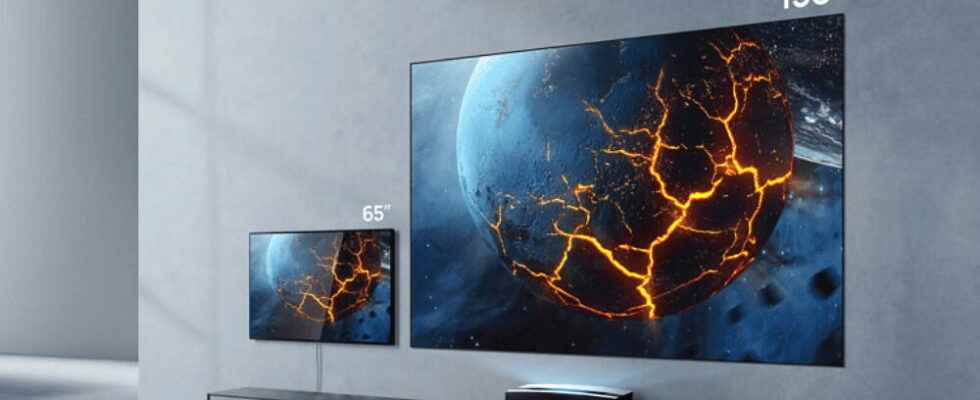If you want to enjoy the home cinema experience in your living room in minutes, you need a lot of space, don’t you? Not at all. Because yourself in a small space can you real cinematic atmosphere set up, assuming the appropriate hardware. Special ultra-short-throw projectors make exactly that possible. We’ll tell you what you need to consider when choosing the right model.
This article answers the following questions:
By the way, you can read more about the subject of “projector or television” in our general projector purchase advice:
Home cinema in a small space: what is an ultra-short-throw projector?
In contrast to a conventional video projector, which requires a distance of several meters from a screen, you can use ultra-short-throw projectors set up directly in front of the screen. A special wide-angle lens, which is located on the top of the projector housing (and not at the front as with normal projectors), outputs the image.
Most ultra-short-distance projectors use a laser as the light source particularly good coloring and low energy consumption guaranteed. Because the ultra-short-throw projector throws the image onto the projection surface at a very oblique angle, it is sufficient small distance to the screento create a large image. If you set up the projector about 20 centimeters in front of the screen, you will already get an image with a diameter of about 60 inches.
A notice: Sometimes ultra short throw projectors are also referred to as UST projectors. It stands for ultra short throw projector.
What are the advantages of a UST projector?
As already mentioned, the purpose of an ultra-short-throw projector is primarily to small space requirement of the device. This offers the following Advantages over conventional projectors:
Which screen is the right one and more: What do you have to consider when buying?
Basically, ultra-short-throw projectors often cost significantly more than conventional projectors because of the built-in laser technology. In addition, there are a few other points that you should consider when buying such a device:
Ultra-short-throw projectors with 4K or Full HD: what are the currently best models?
There is a large selection of ultra-short-throw projectors. We’ve rounded up some of the best devices for you.
UST projector from Epson: high lumen value and many extras
©Epson
Epson EH-LS300W
This currently inexpensive ultra-short-throw projector from Epson scores with a very high value of 3,600 lumens and an excellent contrast ratio. It also has a wealth of different connections on board and offers support for WiFi and Android TV. The device is yours for 1,800 euros.
BenQ ultra short throw projector: True 4K image and USB 3.0
© BenQ
BenQ V6000
The BenQ V6000 gives you fantastic 4K resolution with brilliant colors. In addition, this projector also supports USB 3.0, which makes it particularly interesting for users who want to use the appropriate storage media for playback. The price, if available, is 4,114 euros.
Top projector from Hisense: 4K resolution and Dolby Atmos support
©Hisense
Hisense 100L9G-B12
The Hisense model also supports real 4K resolution and also convinces with Dolby Atmos support. You pay just under 2,999 euros for the laser projector with a screen diagonal of up to 100 inches.
Samsung 4K UST projector: Magnificent picture thanks to triple laser
©Samsung
Samsung 4K Triple Laser Projector LSP9T
Samsung’s 4K model impresses with excellent colors, UHD support and a wealth of connections, including a total of 4 HDMI ports. If you are looking for an ultra-short-distance projector for several playback devices and areas of application at the same time (Blu-ray player, console, streaming box), you will definitely find it here. A screen diagonal between 100 and 130 inches is available for 3,799 euros.
XGIMI Aura: Inexpensive ultra-short-throw projector with 4K and 3D
XGIMI’s ultra-short-throw projector not only supports 4K resolution, but can also display 3D content. It also convinces with a relatively low price of 2,400 euros as a solid model for beginners.
© XGIMI
XGIMI Aura 4K Projector
We hope that our purchase advice can help you to choose the right projector for your space-saving home cinema and wish you a lot of fun with your cinema experience in a small space.
*. . .
